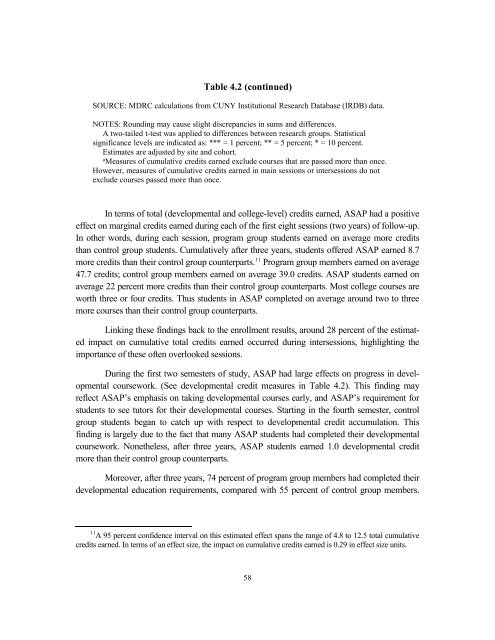1dOprzL
1dOprzL
1dOprzL
You also want an ePaper? Increase the reach of your titles
YUMPU automatically turns print PDFs into web optimized ePapers that Google loves.
Table 4.2 (continued)SOURCE: MDRC calculations from CUNY Institutional Research Database (IRDB) data.NOTES: Rounding may cause slight discrepancies in sums and differences.A two-tailed t-test was applied to differences between research groups. Statisticalsignificance levels are indicated as: *** = 1 percent; ** = 5 percent; * = 10 percent.Estimates are adjusted by site and cohort.aMeasures of cumulative credits earned exclude courses that are passed more than once.However, measures of cumulative credits earned in main sessions or intersessions do notexclude courses passed more than once.In terms of total (developmental and college-level) credits earned, ASAP had a positiveeffect on marginal credits earned during each of the first eight sessions (two years) of follow-up.In other words, during each session, program group students earned on average more creditsthan control group students. Cumulatively after three years, students offered ASAP earned 8.7more credits than their control group counterparts. 11 Program group members earned on average47.7 credits; control group members earned on average 39.0 credits. ASAP students earned onaverage 22 percent more credits than their control group counterparts. Most college courses areworth three or four credits. Thus students in ASAP completed on average around two to threemore courses than their control group counterparts.Linking these findings back to the enrollment results, around 28 percent of the estimatedimpact on cumulative total credits earned occurred during intersessions, highlighting theimportance of these often overlooked sessions.During the first two semesters of study, ASAP had large effects on progress in developmentalcoursework. (See developmental credit measures in Table 4.2). This finding mayreflect ASAP’s emphasis on taking developmental courses early, and ASAP’s requirement forstudents to see tutors for their developmental courses. Starting in the fourth semester, controlgroup students began to catch up with respect to developmental credit accumulation. Thisfinding is largely due to the fact that many ASAP students had completed their developmentalcoursework. Nonetheless, after three years, ASAP students earned 1.0 developmental creditmore than their control group counterparts.Moreover, after three years, 74 percent of program group members had completed theirdevelopmental education requirements, compared with 55 percent of control group members.11 A 95 percent confidence interval on this estimated effect spans the range of 4.8 to 12.5 total cumulativecredits earned. In terms of an effect size, the impact on cumulative credits earned is 0.29 in effect size units.58


